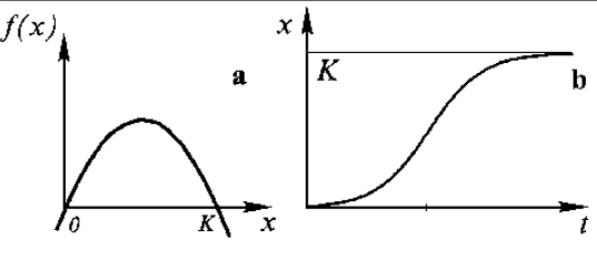
- •Models and modeling models
- •4 Main types of models that are wide used biology and medicine.
- •Mathematical models
- •Types Of Mathematical Models
- •1. Mathematical models are material-mathematical and logical-mathematical.
- •2. Mathematical models are probabilistic and deterministic.
- •Stages of mathematical modelling
- •Mathematical models in biophysics
- •Simple regulation system
- •1. Unlimited growth. Exponential growth. Self-catalysis (Auto-catalysis)
- •2. Bounded growth. The Verhulst equation.
- •3. Competition. Selection
- •Fractals in modeling
Mathematical models in biophysics
Basic mathematical models represented by one or two equations allawing a qualitative examination, make it possible to describe principal regularities of biological processes: growth restrictions, presence of several stable stationary states, oscillations, quasistochastic regimes, spreading pulses and waves, and the structures inhomogeneous in space.
These models are nonlinear and reflect mathematically the openness of biological systems and their state beyond thermodynamic equilibrium.
The imitation models are constructed for all the levels of the organization of live systems, from the subcellular organelles to the biogeocenoses. The development prospects for mathematical models in biology rest on the use of information technologies.
Specificity of mathematical modeling of living systems
Contrary to the diversity of living systems, they all possess the follawing specific features that must be taken into account in constructing the models.
Living systems are:
1. Complex systems.
2. Proliferating systems.
3. Open systems.
4. Multilevel regulation system.
5. Complex spatial structure.

Simple regulation system
Feedforward – direct communication.
Feedback – back coupling, feedback coupling. Feedback can be positive (note by + sign) or negative (note by – sign).
System can be stable only in presence of negative feedbacks; otherwise outer influence or inner change will carry to deviation from equilibrium state up to outside conditions of system existence.
Imitation models of concrete complex living systems, as a rule, take into account all available information about given object
Simple nonlinear dynamic models.
1. Unlimited growth. Exponential growth. Self-catalysis (Auto-catalysis)
The proliferation of plants and animals, whose organization is complex, follaws more complex laws; however, in the simplest model, one may assume that the proliferation rate of a species is proportional to the numbers of this species
Autocatalysis means the "self-acceleration" of a reaction.
2. Bounded growth. The Verhulst equation.
The Verhulst model (1848) is a basic model that describes the limited growth:
dx/dt= rx(1-x/K) (3)
Diagrams of the dependence of the right-hand side of Eq. (3) on the numbers x and on the population numbers in time are presented in figures belaw.

3. Competition. Selection
This effect of grows of predator quantity in condition of victim grows was predicted by the model "predator-victim" proposed by Volterra.
Model of a continuous microorganism culture
Microbiological populations are a good experimental object for verifying ideas and results of both ecological and evolutionary ideas.
Fractals in modeling
A plot of the quantity on a log-log graph versus scale then gives a straight line, whose slope is said to be the fractal dimension. The prototypical example for a fractal is the length of a coastline measured with different length rulers. The shorter the ruler, the longer the length measured, a paradox known as the coastline paradox.
Illustrated above are the fractals known as the Gosper island, Koch snowflake, box fractal, Sierpiński sieve, Barnsley's fern, and Mandelbrot set.
: Suppose the organism has a size of L, then the surface area A is proportional to L2, while the volume V is proportional to L3 assuming that it is in the shape of a sphere.
If the density in the organism ρ is proportional to M / L3 is constant, then L is proportional to M1/3, where M is the total mass of the organism.
Since the heat dissipation from an organism is proportional to its surface area, the total metabolic rate R is proportional to L2 is proportional to M2/3, which is close but not quite the same as the 3/4 power-law.
The 3/4-power law is derived in part from the assumption that mammalian distribution networks are "fractal like" (Figure) and in part from the conjecture that natural selection has tended to maximize metabolic capacity "by maintaining networks that occupy a fixed percentage (6 - 7%) of the volume of the body".
